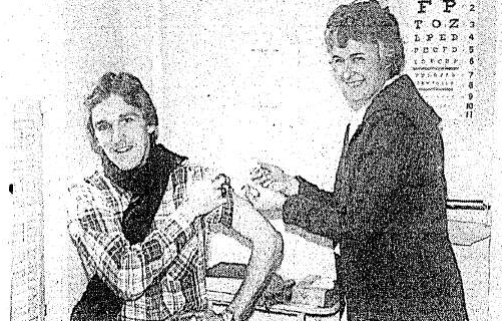
This year marks a full century since the 1918 worldwide influenza pandemic, during which four World War I Hillsdale student draftees came down with the flu.
That epidemic was not the worst Hillsdale has seen, however. While the college was not widely harmed by this outbreak of the H1N1 influenza virus, it was severely affected by an outbreak of the Russian flu in 1978.
An October 31, 1918 issue of The Collegian credited the flu’s absence to the college’s careful health safeguards.
“The college has been particularly fortunate in escaping the epidemic. This has been due in large part to the precautions taken by the students and faculty in not holding any unnecessary meetings.”
Although college students for the most part avoided catching the flu in 1918, the flu prevented the college’s athletic teams from participating in events with other colleges. According to the 1919 issue of the Hillsdale Winona Yearbook, when “the epidemic of ‘flu’ came along . . . many of the colleges cancelled all games, leaving us with no games to play.” According to Linda Moore, “A number of students got it at home or in the army and didn’t come back, so it did cause a disruption for the college.”
Hillsdale students in the armed forces were affected by the flu as well. After entering WWI, the U.S. government created the Student Army Training Corps (S.A.T.C.) in 1918 with the intention of forming a military unit in every college capable of providing 100 military-age men, eventually gathering draftees from a total of 157 colleges and universities. The barracks of the Hillsdale S.A.T.C. unit were located at the old Shoe Factory on Manning Street, and a flu outbreak in the barracks impeded the discharge of Hillsdale’s (S.A.T.C.) unit.
“Dr. Sawyer, who is the contract surgeon for this post, pronounced four cases to be influenza,” The Collegian reported on Dec. 12, 1918. “[D]emobilization and the mustering of the men out of the service will be held up indefinitely until the influenza has been entirely wiped out.”
Hillsdale experienced a much more serious bout of the flu during the Russian influenza in 1978. In 1977 this virus spread throughout the world but no one was able to trace its origin. It was first recognized in Russia, giving it its name, but many scientists suspect the pandemic actually started in China and affected people mostly under the age of 25. Hillsdale’s physician at the time, Charles Vear, estimated had affected 70 percent of the student body.
“Hillsdale College fell victim to a potent flu virus last week that eventually incapacitated the majority of its college students,” The Collegian reported on Feb. 23, 1978.
Sara Van Camp, the director of the Student Health Service in 1978, told The Collegian that health service employees had been seeing 50-70 students per day and that they had added an extra two nurses to handle the overflow of sick students. The Academic Dean’s office also told The Collegian that class absences had increased significantly.
“A number of students were quarantined and the college was taking food to them instead of them being out at the dining hall,” Moore said.
The virus affected college athletics again as well.
“Colds and flu forced 14 members of the Hillsdale [track] squad to stay home and allowed the Miami trackmen to dominate the meet,” Hillsdale’s Alumni Magazine reported on April 1, 1979.
Regardless of the other outcomes, the 1918 epidemic didn’t stop homework.
“Prof. Harry Mack is a victim of the second flu epidemic,” The Collegian reported on Dec. 19, 1918, referring to the Hillsdale’s second outbreak. “Though students had a vacation from his class, the assignments posted in his room kept them busy in the library. If only he could have seen us!”

